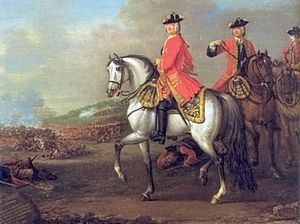Sir Robert Rich, 4th Baronet facts for kids
Quick facts for kids
Sir Robert Rich, Bt
|
|
|---|---|

Portrait by William Aikman
|
|
| Born | 3 July 1685 Roos Hall, Beccles, Suffolk, England |
| Died | 1 February 1768 (aged 82) Roos Hall, Beccles, Suffolk, Great Britain |
| Allegiance | |
| Service/ |
|
| Years of service | 1700–1768 |
| Rank | Field Marshal |
| Battles/wars | |
Field Marshal Sir Robert Rich, 4th Baronet (born July 3, 1685 – died February 1, 1768) was an important British cavalry officer. He started his army career as a young officer. He fought in major battles like the Battle of Schellenberg and the Battle of Blenheim. These battles happened during a big conflict called the War of the Spanish Succession.
Later, he was asked to create a new army group. This was to help stop a rebellion known as the Jacobite rising of 1715. He also served in another war, the War of the Austrian Succession. Here, he fought at the Battle of Dettingen. Besides his military work, he was also a Member of Parliament. This meant he represented people in the government. He served for three different areas.
A Life in the Army and Politics
Robert Rich was the son of Sir Robert Rich, 2nd Baronet. He began his army journey on June 10, 1700. He started as an ensign in the 1st Regiment of Foot Guards. This was a low-ranking officer position.
He saw a lot of action in the War of the Spanish Succession. In July 1704, he fought at the Battle of Schellenberg. He was hurt during this battle. Just a month later, in August 1704, he fought at the Battle of Blenheim. He was wounded again there.
After these battles, he moved up in rank. He became a lieutenant and then a captain in the army. In October 1706, he became the 4th Baronet after his brother Charles passed away. By March 1708, he was a lieutenant-colonel in the army. In June 1708, he was involved in a duel. His opponent, Sir Edmund Bacon, was injured but survived.
When the Jacobite rising of 1715 began, Sir Robert was given a big task. He was asked to form a new army regiment. This group became known as the 18th Dragoons. That same year, he was also chosen to be a Member of Parliament for Dunwich.
In June 1717, he lost command of his regiment. This happened because he voted against the government's view on a certain issue. He lost his election in 1722. However, he had strongly supported Sir Robert Walpole, a powerful politician. Because of this support, he was given command of the 13th Hussars in November 1722.
In February 1724, he was elected as a Member of Parliament for Bere Alston. In September 1725, he became the colonel of Sir Robert Rich's Regiment of Dragoons. In 1727, he changed his constituency to St Ives. He also became a Groom of the Bedchamber to King George II. This was a special role where he served the King personally. He held this position until 1759.
Sir Robert continued to rise through the military ranks. He was promoted to brigadier-general in March 1727. He then led several different regiments. These included The King's Regiment of Carabineers, the 1st Troop Horse of Grenadier Guards, and the 4th Regiment of Dragoons.
He became a major-general in December 1735 and a lieutenant general in July 1739. In May 1740, he was made Governor of the Royal Hospital Chelsea. This hospital was a home for old soldiers. He served with the Pragmatic Army at the Battle of Dettingen in June 1743. This battle was part of the War of the Austrian Succession. He also led a military trial in August 1756. This trial was for another general accused of not following orders.
Sir Robert Rich was promoted to general of horse in March 1746. His highest military rank came on December 3, 1757. He was made a field marshal. After retiring, he lived at his family home, Roos Hall in Beccles. He passed away on February 1, 1768.
Family Life
In 1710, Sir Robert Rich married Elizabeth Griffith. They had three sons together. Two of their sons, Sir Robert Rich, 5th Baronet and Sir George Rich, 6th Baronet, also became baronets. They also had one daughter named Elizabeth. She later married George Lyttelton, 1st Baron Lyttelton.
Images for kids



